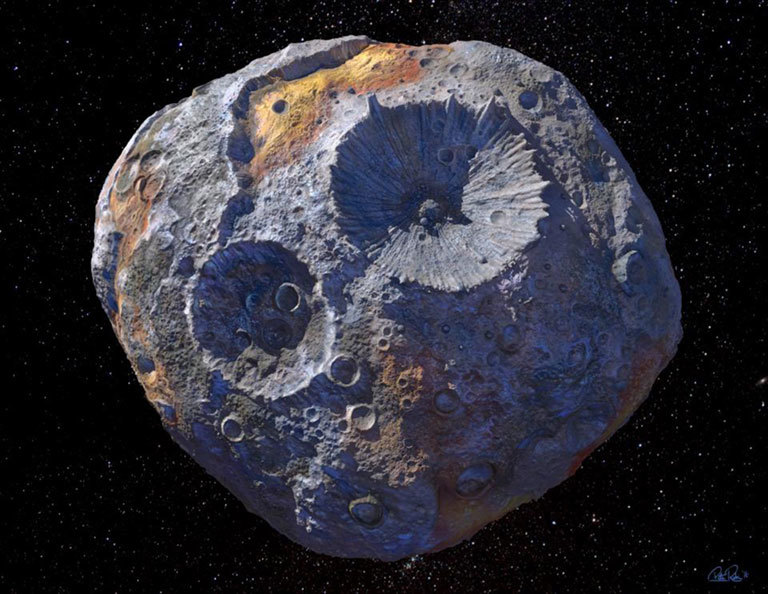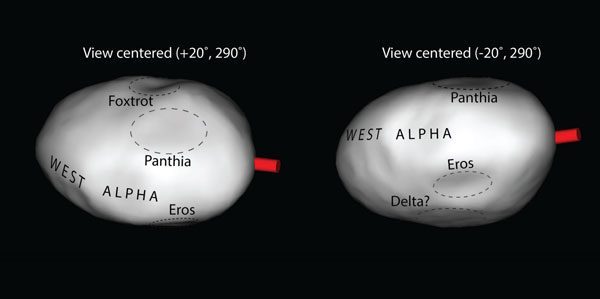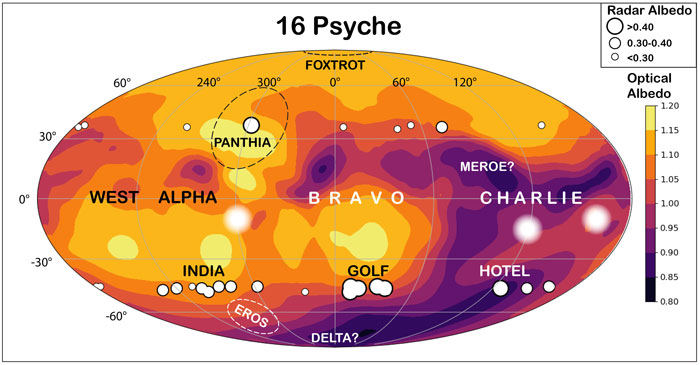A new study of asteroid 16 Psyche suggests that ancient ferrovolcanism, volcanoes that spewed molten iron, might have been present on this solar system object.
Asteroid (16) Psyche is the largest metallic, or M-class, asteroid in the solar system and the destination of NASA’s Psyche mission, set to launch in 2022. But what this world will look like is up for debate. Perhaps the most tantalizing scenario is that this world once oozed iron lava, a phenomenon known as ferrovolcanism. Now, a new study in press in The Planetary Science Journal provides strong evidence for ancient iron volcanoes on Psyche’s surface.

Courtesy of Maxar / ASU / P. Rubin / NASA / JPL-Caltech
The presence of iron on Psyche’s surface, which another study recently confirmed, initially led astronomers to propose that the asteroid is an exposed planetary core, uncovered after violent collisions with other objects. However, recent measurements revealed that the asteroid’s overall density is surprisingly low, suggesting it might be porous or simply a conglomerate of rubble, and not a planetary core after all.
In their new study, Michael Shepard (Bloomsburg University) and his collaborators analyzed features on Psyche’s surface and refined measurements of its size and shape. Shepard’s team also studied Psyche’s albedo, a measurement of how reflective a surface is to both visible light and radar. In the first composite albedo map of Psyche, they showed that areas with high visible-light reflectivity, or high albedo, are also highly radar reflective. This correlation, the authors argue, furthers the case for ancient ferrovolcanism as opposed to a barren metal core.
The Shape of Psyche
Shepard’s team used radio and visible-light observations from the Atacama Large Millimeter/submillimeter Array (ALMA) and the Very Large Telescope (VLT) in Chile, from the Keck Observatory in Hawai‘i, and from amateur astronomers, to help compose a new 3D model of the asteroid’s shape. Based on their model, Psyche is about 278 kilometers (172 miles) long, in agreement with prior studies. This size, in conjunction with the approximate mass of Psyche, leads to an overall density of only 4 grams per cubic centimeter — that's much less than astronomers would expect from an iron-nickel core.

Shepard et al.

Shepard et al.
In 2020, Brandon Johnson (Purdue University) and his colleagues proposed in Nature Astronomy that a differentiated body that had experienced ferrovolcanism could explain Psyche’s low density. Sulfur mixed with iron in the core could cause metallic melt to spew out onto the surface, if the mantle were thin enough. This theory, Shepard states, is the most likely model given the results of their new study.
Shepard also assessed the likelihood that each surface feature in their new shape model is genuine and not just an artifact of their modeling. Features dubbed Bravo, Charlie, Eros, and Panthia are the most likely to be real craters or depressions on Psyche’s surface, as they appeared in multiple observations and studies. Panthia in particular displays characteristics of an impact crater and happens to be an area of high visible-light and radar albedo. Its structure, and the lack of other features like it, may help determine which mechanisms are responsible for Psyche’s metal content.
Psyche is Shiny (in Some Places)
The radar albedo shows that Psyche’s surface density is quite high, even if its overall density is not, which suggests that the surface rubble has a lot of metals. The albedo depends on location, which means certain areas (like bright Panthia) might be punctuated with higher metal content. These spots might have been the eruption points for ferrovolcanism.

Shepard et al.
The most convincing evidence for ancient ferrovolcanism is that the highly radar-reflective areas tend to reflect lots of visible light, too. Impacts could produce the localized areas of high albedo, but only one radar-reflective spot pairs with an impact site (Panthia). It is not clear how impacts could rearrange rubble into metal-heavy areas that are reflective to visible light. In contrast, products of ferrovolcanic activity, such as fine-grain silicates or iron slabs, would reflect both visible light and radar.
Johnson agrees that Shepard’s data further the case for ancient iron volcanoes. “This the first time that radar albedo variations have been combined with albedo maps. Although the view is fuzzy at this point, it is clear something interesting is going on with the optically and radar bright regions. The work certainly has me more excited for the Psyche mission.”
The Psyche spacecraft is scheduled to arrive at the asteroid in 2026, so there’s still time to wonder what this space rock has in store. “I fully expect to be surprised by what Psyche reveals,” says Johnson.
Editorial note (June 22, 2021): This post was updated to clarify that the study shows evidence for ancient ferrovolcanism.
 5
5









Comments
John-Murrell
June 18, 2021 at 4:37 pm
If 16 Psyche has Iron - Sulphur volcanoes where does the energy come from to melt the core material so it can be ejected in a volcano - it is too small for radio active heating to still work.
Also if it has volcanoes these should show up either as an infrared heat excess or as hot spots on an infrared image if there is one of sufficient resolution.
You must be logged in to post a comment.
Mike-Edmunds
June 18, 2021 at 7:29 pm
I agree with John-Murrell. How do you melt such a small body? The bright areas are more likely relatively fresh impact craters and their ejecta that has not been weathered by exposure to the space environment.
You must be logged in to post a comment.
Yaron Sheffer
June 21, 2021 at 9:49 am
Assuming the composition is correct, perhaps age is a factor. Any volcanic activity must have happened eons ago, making this body as dead as a metallic door nail by now... albeit still covered by very cold and solid reflective metallic residue.
You must be logged in to post a comment.
Lauren SgroPost Author
June 22, 2021 at 10:16 am
Hello John-Murrell (and others who have commented!). Yaron Sheffer is correct in that the ferrovolcanism is proposed as past activity. There are no claims in the study for current volcanism, but that the regions of high visible-light and radar albedo are the products of potential past eruptions. We have updated the text to make this clear!
You must be logged in to post a comment.
epatrick
June 22, 2021 at 1:56 pm
I agree with the comments here. With a surface of iron (Fe), there is likely to be an extremely fine powder of single-phase iron (Fe(0)) everywhere. These will be particles from the micron size all the way down to individual Fe atoms. Unlike the mish-mashed lunar surface, micrometeoroids have a much more limited range of materials to pulverize. It will be very interesting to survey with instruments. I would expect a giant cloud of these space-weathered grains and particles to create a regolith "fog" when any spacecraft contacts it. These particles would go into orbit. Some would fall back to the surface, but some would go into orbit for days if not years. Also, I would expect the regolith fines to be extremely reactive to any exposure to rocket engine combustion byproducts. The Apollo sample I have in the lab (10084,27) eats O2 under UHV conditions so I expect that Psyche can vacuum up as many reactive gas molecules (H2O, NH3, H2NNH2, HCN, NCCN, etc.) as we can throw at it. It would be nice to get to the innate paleocosmic volatile history of such worlds before we blast them into oblivion with supersonic molecular beams of polybutyl bovine and dimethyl chicken-wire from our spacecraft engines.
You must be logged in to post a comment.
You must be logged in to post a comment.